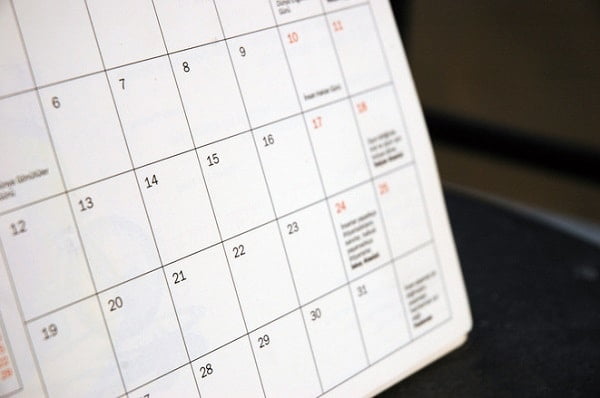Table of Contents
- What is a Conception Calculator
- How Does It Work?
- How is the Conception Date Calculated and What is it Based On?
- Facts about Conception
- Calculating based on your Estimated Due Date
- Calculating Based on your LMP
- Calculating Based on Ovulation Dates/Fertile Period
- Calculating Based on your Ultrasound
- What Can Affect Conception Dates
- Is the conception calculator practical?
- FAQ’s
What is a Conception Calculator

Photo: Pixabay
A pregnancy conception calculator can help you determine when your baby was conceived, based on a few different factors such as the first date of your last menstrual period (LMP), the due date of your baby, or when the baby was actually born.
The pregnancy conception calculator estimates the date of conception according to the anticipated due date of pregnancy. The calculator also quotes a possible selection of days where sexual intercourse may have resulted in conception according to the fact that sperm lives for 3-5 days inside a female’s body.
Whichever method you choose to use in order to determine the date of conception, it will give you a range (which will coincide with your fertile period) to go by.
You can input the information into the conception calculator below in order to come up with that time-frame. This is when knowing when your period started is important, especially if you haven’t been to the doctor yet.
from Birth, LMP and Due dates.
These estimated conception dates are based on an average cycle of 28 days.
To use thecalculator:
These estimated conception dates are based on an average cycle of 28 days, which is what most calculators are based on.
While we are aware that some people have a longer or shorter cycle, an average of 28 days is used while calculating the date of conception.
How Does It Work?
The conception calculator figures the gestational age of the baby to determine the date of conception. Since the exact date of conception is hardly ever known, the conception calculator can use the first day of the last menstrual period (LMP) you have to determine the range of days in which conception would have occurred.
You can also use the conception calculator if you know the due date of your baby. The baby can typically be dated 5 or 6 weeks after your last menstrual period to determine the gestational age of the baby and the approximate due date.
If you know either of these figures, you can input this information into the conception calculator along with the current date to find out the possible days of conception.
Again, the conception calculator bases this off of the average 28-day cycle. If you have a shorter or longer cycle you will have to account for that manually, moving the range over a few days in either direction so to speak.
How is the Conception Date Calculated and What is it Based On?
This process is based on a typical, textbook pregnancy. This means that we calculate it based on a pregnancy that lasts 40 weeks in woman with a 28-day cycle.
So if you are using the calculator with the day the baby was born that could skew the results, especially if your baby was born earlier or later (which can happen during any pregnancy).
In order to calculate the estimated conception date, the calculator will use the last menstrual period date, and then add 12-16 days to it.
With the estimated delivery date, it will count back 38 weeks to give an approximate date of conception.
The conception calculator is great for mothers or expecting mothers who are interested in finding out when their baby was conceived (you know, either that trip to the Islands or when the power was out).
Now there are other calculators that we offer, such as ovulation calculators, implantation calculator, due date calculators, and sexual intercourse timing calculators.
These are useful for women interested in their fertility and determining when they have the best chance of becoming pregnant or when their next menstrual cycle will happen.
Facts about Conception
Women who experience regular period cycles typically conceive about 11-21 days after the first day of their last menstrual period.
Determining the exact date of conception is difficult and so your conception date is mostly an estimate based on your period cycle.
There are, however, special cases, such as women who are artificially inseminated or use in vitro fertilization, know the exact date of their conception.
Surprisingly, there are a lot of people who don’t actually know that you cannot conceive any time during the month.
According to one survey, more than 50% of respondents to a survey thought that this was the case, that no matter when you had intercourse you could get pregnant.
This causes many people to actually think they are infertile, when in fact they don’t know that there is a specific fertile period to go by.
Calculating based on your Estimated Due Date
Typically, your estimated due date is about 40 weeks from the first of your last menstrual period, but this is just an estimate.
While we consider pregnancy to be 280 days (40 weeks), it’s really only about 38 because the two weeks before/during ovulation you aren’t pregnant. You likely did not conceive till two weeks after the start of your cycle. (Embryonic growth lags two weeks on your pregnancy).
Figuring out your conception date based on your EDD is also an estimation. And while you are given an EDD, a lot of babies are not actually born on that day.
If you are trying to calculate the approximate conception date based on your due date you would take your due date and subtract 266 days. This would bring you back to your rough conception date.
Calculating Based on your LMP
With regards to the Last Menstrual Period or the LMP, it is pretty straightforward to calculate. But this can be confusing for women who have irregular periods.
Basically, the first day of your menstrual cycle is also the first day of your LMP. This works well if you have a regular cycle and those who are using natural family planning will be very astute to when their periods will come, when their body is ovulating, and when to expect PMS, etc.
However, most of the time, the first day of the LMP is usually what’s needed and nothing more with regards to that period.
Girls are in their fertile window to conceive a baby when they are ovulating. During the ovulation, girls release an egg from one of their ovaries. The newly released egg can travel down to the fallopian tube, male sperm can also swim up into the fallopian tubes, and it results in the fertilization.
Ovulation happens typically about two weeks following your menstrual period and continues for a couple of days. However, not all girls have exactly the same duration of cycles.
Many women’s menstrual cycles are very irregular. Others have ovulation intervals closer to or farther away from their menstrual period. That’s why calculating conception by focusing only on your body cycles can be hard.
Calculating Based on Ovulation Dates/Fertile Period
You can also get to know your ovulation date by using the Ovulation Calculator. As mentioned above, the exact date will depend on having a regular period which is on average 28 days (from the first day of one period to the first day of your next period).
Some women can tell when they ovulate, and this gives them a very good indicator as to when they conceived as well.
Women who are in turn with their bodies can notice the subtle changes such as changes in the cervical mucus, heightened sense of smell, breast tenderness, pelvic or lower abdominal pain (some can even tell which side they ovulated from), light spotting, and a heightened sex drive (your body wants you to get pregnant).
Knowing when you ovulate can help you get pregnant. Fertilization occurs when the sperm meets and finds its way into the egg which happens within 24 hours after ovulation.
And remember, sperm can survive inside the female for five to seven days, so you could conceive, even if you didn’t have intercourse on that day.
The basal temperature method is another way to figure out the days past ovulation, otherwise known as your luteal phase, which are the days between ovulation and the day before your next period.
Calculating Based on your Ultrasound
Another way to find your estimated date of conception is through an ultrasound. Ultrasounds are typically conducted between 8 and 20 weeks of pregnancy and are used to determine the gestational age of the pregnancy.
What Can Affect Conception Dates
There are many factors that can affect when you can conceive. Sperm only last from three to five days, and ultimately it is important to get that sperm into the woman during ovulation.
However, there are things that affect ovulation time-frames. Even when you generally have a regular cycle, there are situations in life that can make that cycle go awry.
There are also things that can affect conception even if you are having intercourse during your ovulation period.
Your body also has to be healthy, and if it isn’t then you might not actually conceive. When there is a lack of nutrients in the body such as zinc, vitamin D, vitamin B6, it could affect the reproductive hormones, which naturally can affect conception.
Another big factor when it comes to conception would be stress. When stress hormones are high, there is a 29 percent lower chance of getting pregnant.
So that stressful job, life, arguments, and illness can all wreak havoc on the body and conception. Take a break from the stressors in life and find a way to create a Zen place in order to help you conceive.
Medications are another huge one. Antibiotics especially, as well as other medications, can cause a delay in your ovulation and your cycle, which means that if your cycle has been altered, you won’t be able to accurately estimate when you conceived.
Additionally, eggs typically take from 12 to 24 hours to shed, meaning that the conception date may be off by one day.
Is the conception calculator practical?
The practicality of using this calculator varies from woman to woman. Although it can’t say that a baby was conceived on that specific date with 100% certainty, it can provide a solid prediction.
In addition, in situations where a woman had different partners at a given time and would like to know the father of her baby, using a conception calculator can give her a clue. However, a paternity test will be much more reliable in this case, especially if the woman wasn’t ovulating during those times.
Still, the only way to accurately know the exact conception date is when pregnancy is conceived through treatments such as artificial insemination and in vitro fertilization; otherwise, the conception calculator can only give you an estimated idea of the time your baby was conceived.
That is the reason a pregnancy affirmation ultrasound would be the very best method to understand just how far along your pregnancy is.
Pregnancy ultrasounds look right at the crown rump length (CRL), which is the length of fetus from head to buttocks, to determine its age. This way is a lot more precise than date-based calculation.
Frequently Asked Questions About Conception Dates and Conception Calculators
Is the date given accurate?
It’s an estimate and gives a range based on your fertile period. The only way to know for a fact when you conceived is if you only had intercourse once between your cycles. The only way to know for sure is through ultrasound scan done after 8 weeks of pregnancy.
ezstandalone.cmd.push(function () { ezstandalone.showAds(119); });Can the conception date determine the father of my child?
It depends on when you were fertile and when you had intercourse. If you had intercourse with multiple partners during that time-frame, it could be either of them and the only way to accurately know is by a DNA test.
ezstandalone.cmd.push(function () { ezstandalone.showAds(119); });Why would I want to use a conception calculator?
As said in the above question, you might want to have a range as to when you actually conceived, especially if you were with multiple partners. You also might want to have an idea as to where you conceived to tell your children later on and embarrass them.
ezstandalone.cmd.push(function () { ezstandalone.showAds(119); });Do you have any other question about your period, ovulation, pregnancy or other related topics? Check out our Frequently Asked Questions page.
References
-
1. Sozou, P. D., & Hartshorne, G. M. (2012). Time to pregnancy: a computational method for using the duration of non-conception for predicting conception. PloS one, 7(10), e46544.
2. Gnoth, C., Godehardt, D., Godehardt, E., Frank‐Herrmann, P., & Freundl, G. (2003). Time to pregnancy: results of the German prospective study and impact on the management of infertility. Human Reproduction, 18(9), 1959-1966.
3. Abell, A., Juul, S., & Bonde, J. P. E. (2000). Time to pregnancy among female greenhouse workers. Scandinavian journal of work, environment & health, 131-136.
4. Mathiesen, J. M., Secher, A. L., Ringholm, L., Nørgaard, K., Hommel, E., Andersen, H. U., … & Mathiesen, E. R. (2014). Changes in basal rates and bolus calculator settings in insulin pumps during pregnancy in women with type 1 diabetes. The Journal of Maternal-Fetal & Neonatal Medicine, 27(7), 724-728.
5. Diedrich, J., Cortez, S., Benzoni, N., & Madden, T. (2015). Pregnancy calculator and cost-effectiveness analysis of three methods of postcoital contraception. Contraception, 92(4), 388.
6. Thomas, G. M., Lupton, D., & Pedersen, S. (2018). ‘The appy for a happy pappy’: expectant fatherhood and pregnancy apps. Journal of Gender Studies, 27(7), 759-770.




Hi , I had sex with guy A on april 10 , then I got my period april 25 ( my periods are regular) and that was the last time guy A and I had sex. Then May 6 I had sex with guy B and we was together the whole may
my (may) menstrual period didn’t come and I never missed a period in my life then june passed no period july passed no period july 24 i went to the hospital and I had ultrasound and I was 12weeks 6 days and my due date is January 30th. I just want to make sure guy B is the father
I had sex with my husband October 12th 2020 there was blood during intercourse. I started my period and he did ejaculate inside of me. I had sex with another man October 21st. Who could possibly be the father. My baby was born on July 19th exact due date from Lmp.
I am curious as to when I conceived and who is baby’s father? I was with my partner all January then we broke up and I slept with someone else February 3rd. My due date is October 15th. I had a transvaginal ultrasound February 26th that stated I was 6 weeks and 6 days pregnant? How accurate are those? Everything leads to my partner being the father so far but still not too sure.
Hi, i had unprotected sex with a guy on the 10th of February i have irregular periods and i had my periods on the the 6 of january and ended on the 10th and had again my periods on the 14th to 18th i just want to know which date did i conceive
I was 10 weeks 5days pregnant on November 19. I was having irregular periods and the whole month of September I never had one. I’m due June 12 and some websites say I conceived September 5, some say the 19th. I had sex with my boyfriend on august 22,24 also September 18/19. The other boy I had sex with at the end of September maybe October. I found out I was pregnant October 2. Who could be the father?
Hello Kislee! Congratulations on your bundle of joy. Actually, your probable fertile window is September 20. So you conceived around September 16 to September 24. This means your boyfriend is the father.
I had unprotected sex with a my girlfriend three times on the 14th feb. She’s had no period since but negative pregnancy test.
Hello Nathaniel! There are a number of things that could cause missed periods including stress, lifestyle and a lot more. Pregnancy is one but you need to have a positive test to confirm. There are also instances that test kits show negative but other tests would say the opposite. I suggest a visit to the doctor to confirm the real status of your girlfriend.
Hello! My period is irregular. March 8-14, April 12-18, May 1-7, May 18-24, then June 26-July 2. I’m due on April 9, 2021 and I had sexual intercourse with guy A on July 9 and he did not cum inside. Then I had sex with guy B on the 15, 18, and 19 and came inside me. Who is most likely responsible?
Hello Jenny! Good luck on your new bundle of joy. My response may be late since you already know who the father is this time. But I’ll give you my answer anyway. If we calculate your due date, your probable fertile windows is July 18, 2020. You had sex with guy B with no protection and he is probably the father of your baby. I hope this helps!
I had sex with guy A on dec 21, 2020 and had sex with guy B on dec 30, 2020. I have three different due dates. The first one is Sept. 24, the second due date is Sept. 22 and the third due date is Sept. 21. Is there any way to tell who the father may be???
Hello Jess!
If we use the conception calculator, the three due dates all say that guy B is the father of your baby. The probable fertile window based on your due dates ranges from Dec. 27-January 4. And since you had sex with Guy B on the 30th, you possibly conceived with him.